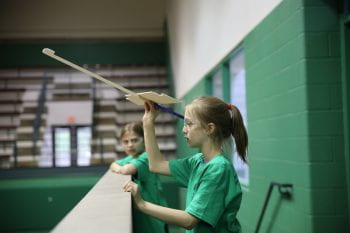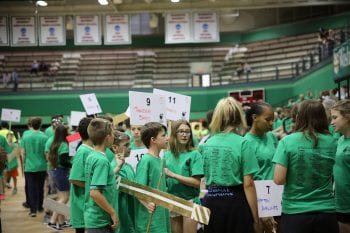“This is stressful,” Emilia Talarski says in between bites of pizza.
She’s worried her balsa wood glider will break. Although, it already has a crack. It happened when she fell while holding it. But she describes it as a happy accident.
“It actually made the glider fly better,” says the third grader from MOSAIC Elementary School in Mehlville. “That’s the farthest it has ever flown.”
So, no fixes for now. Sitting beside her mom, Emilia is waiting to test fly her glider in the Washington University Field House. She’s one of 300 students that have turned out for the 10th annual Boeing Engineering Challenge held May 2. Usually open to middle and high school students, this year for the first time the competition allowed elementary students to take part.

“Initially there was too much weight on the front and it would nose dive, so we added weight to the back and now it’s just right,” Emilia says.
Lisa Talarski, Emilia’s mom is proud of her daughter’s ability to problem-solve.
“It’s a good opportunity to see that most things don’t work out the first time and to experiment with them,” she says.
Throughout the school year, students worked with their physics teachers and Boeing engineer mentors to construct their gliders. Some 1,300 students have participated in the challenge throughout its history.
Ryan Blake and Mitch Campbell both took part in the challenge in 2012. They fondly recall taking third place for longest flight. This time they returned as Boeing engineers, helping to hand out awards.
Blake, a mechanical engineer at Boeing, credits an aerospace engineering class he took at Marquette High School in Rockwood with sparking his interest in planes.“The class really introduced me to what aerospace engineering was like, and by the time I was a junior in college I had chosen Boeing as the place to work,” he says. “Thinking back to events like this – the Boeing Engineering Challenge helped pave the way for me, and now I am working for Boeing as an engineer and getting paid to build airplanes.”

Since the first glider was launched 10 years the event has evolved from one where students simply built and launched a glider to one where the glider must carry a payload of ping-pong balls and drop them within a designated area.
“I’m blown away by all the different designs,” says Boeing engineer and longtime volunteer mentor Tom Brandt. “Sometimes kids come up with designs… and I can’t tell you how they fly, but they do.”
Eighty-seven teams from 21 different schools across the region participated in the 10thannual event. One middle school and one elementary school were represented, the rest were high schools.
Medals were awarded to students whose gliders had the farthest flight, straightest path, longest hang time and best quality of flight. Planes with the most creative appearance and most creative engineering also were recognized.
The victors for the day included:
- Game of Throws from Calhoun High School won Division 1 overall
- Delta Force 6 from Wentzville Holt High School won Division 2 overall
- Blackhawks* from Rockwood’s Marquette High School won Division 3 overall
The annual Boeing Engineering Challenge is sponsored by Boeing in collaboration with Washington University’s Institute for School Partnership and School of Engineering & Applied Science.
May 2018 | by, Myra Lopez
